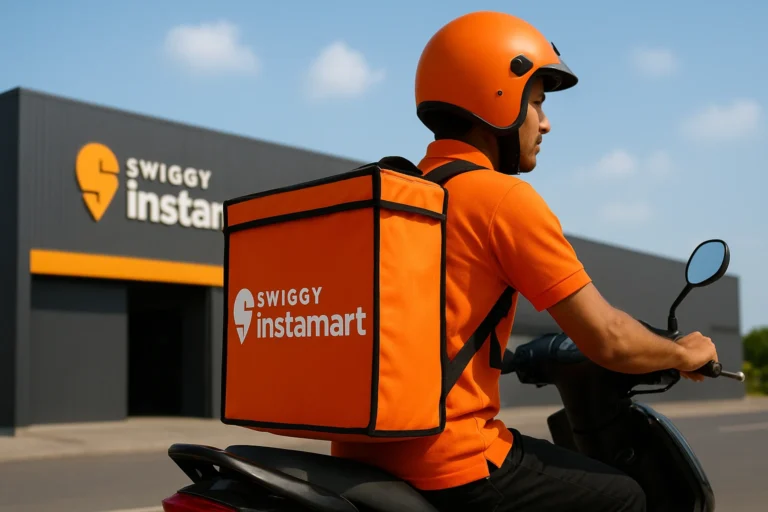Key Takeaways
- Blinkit has redefined India’s quick commerce model with 10–20 minute delivery.
- Zomato’s acquisition of Blinkit accelerated funding, infrastructure, and customer acquisition.
- Franchise opportunities may emerge as Blinkit expands into Tier-2 and Tier-3 cities.
- Competitive benchmarking: Zepto, Swiggy Instamart, and Dunzo’s strategies compared.
The Rise of Blinkit in India’s Quick Commerce Market
Blinkit, formerly Grofers, has become one of India’s most recognizable names in 10-minute grocery delivery. Its pivot from bulk delivery to hyperlocal quick commerce has reshaped consumer behavior, especially in metros. With over 500 dark stores, Blinkit is not just a delivery service—it’s a logistics revolution.
In 2022, Zomato acquired Blinkit for $568 million, giving the company financial strength and a wider customer funnel. Since then, Blinkit has shown consistent growth, recently overtaking Swiggy Instamart in monthly orders according to Redseer data.
Blinkit’s Franchise Possibilities – Fact or Fiction?
Currently, Blinkit operates on a dark store model (company-owned or partner-managed micro-warehouses). However, there’s growing speculation about Blinkit’s potential franchise model to scale in Tier-2/3 cities.
- Why it matters: Franchise partnerships can help Blinkit lower expansion costs while giving local entrepreneurs a high-demand business.
- Challenges: Maintaining 10-minute delivery SLAs in smaller cities, inventory sync, and tech integration.
- Case Study Comparison: Domino’s India successfully scaled through a franchise model in semi-urban markets; Blinkit could replicate this strategy.
Blinkit vs. Rivals: The Franchise Angle
Zepto
- Aggressive Gen-Z branding.
- Focused on company-owned stores for tighter control.
Swiggy Instamart
- Uses Swiggy’s delivery fleet.
- Still limited in Tier-2 penetration.
Dunzo
- Backed by Reliance but struggling with operational costs.
Franchise Insight: None of Blinkit’s rivals have announced a franchise program yet—giving Blinkit first-mover advantage if it enters this space.
Hybrid Tracking: Blinkit’s Data-Driven Funnel
One underrated strength of Blinkit is its data tracking system:
- Consumer funnel: App installs → free delivery offers → grocery habit lock-in.
- Franchise funnel (potential): Local partners onboard → revenue sharing → hyperlocal logistics powered by Blinkit’s AI-driven demand prediction.
This hybrid funnel mirrors successful models in food delivery (Zomato/Swiggy) but with a stronger emphasis on repeat purchases.
What’s Next for Franchise Investors?
- Watch for Blinkit’s official franchise announcements (rumors point to late 2025).
- Tier-2/3 markets could open the most profitable windows.
- Franchisees may gain from low CAC (Customer Acquisition Cost) since Blinkit already dominates app installs and brand recall.
If Blinkit confirms a franchise model, early adopters could capture first-mover advantage similar to how KFC, Domino’s, and McDonald’s expanded in India’s F&B franchise market.
Conclusion
Blinkit is not just redefining quick commerce logistics—it may soon redefine franchise opportunities in India’s retail ecosystem. While no official announcement has been made, industry signals suggest that Blinkit’s franchise model could be the next big wave for investors and entrepreneurs.
For now, staying updated on Blinkit’s expansion and benchmarking it against rivals is the smartest strategy for franchise aspirants.





